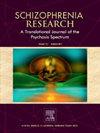Network analysis of psychotic symptoms in schizophrenia
IF 3.6
2区 医学
Q1 PSYCHIATRY
引用次数: 0
Abstract
Background
Schizophrenia with a wide range of psychotic symptoms which indicate the severity of disorders, risk of relapse, frequency and duration of hospitalization, and decreases social and occupational function. In clinical practice, Positive and Negative Systems Scale always used for assessment the severity of psychotic symptoms of patients with schizophrenia. This network analysis explores the inter-relationship of psychotic symptoms of patients with based on Positive and Negative Systems Scale (PANSS).
Methods
The psychotic symptoms of the patients with schizophrenia were assessed by psychiatrist using PANSS when the first day in hospitalization. The network structure of psychotic symptoms was modelled with a graph and characterized using “Expected Influence” and “Bridge Expected Influence” as influential indices in the symptom network. Network stability was tested using a case-dropping bootstrap procedure. Network Comparison Test (NCT) was conducted to examine whether network characteristics differed on the basis of gender.
Results
A total of 799 patients with schizophrenia were included. The mean age of the included participants was 39.51(standard deviation (SD)13.93). The main finding of the study was Preoccupation, Emotional instability and Anxiety were the most influential psychotic symptoms, while Active social avoidance, Emotional instability and Preoccupation were the most bridge influential psychotic symptoms within the interpret-able level of influential in the network. Gender did not significantly affect the overall network structure.
Conclusion
This influential (Preoccupation, Emotional instability and Anxiety) and bridge influential symptoms (Active social avoidance, Emotional instability and Preoccupation) dimension could be addressed in treatment target and treatment response for the patients with schizophrenia.
精神分裂症患者精神症状的网络分析。
背景:精神分裂症具有多种精神病性症状,这些症状表明了精神分裂症的严重程度、复发风险、住院频率和住院时间,并降低了患者的社会和职业功能。在临床实践中,阳性和阴性系统量表通常用于评估精神分裂症患者精神病性症状的严重程度。本网络分析探讨了基于阳性和阴性系统量表(PANSS)的精神分裂症患者精神症状的相互关系:方法:精神科医生在精神分裂症患者住院第一天使用 PANSS 对其精神症状进行评估。精神症状的网络结构采用图形建模,并以 "预期影响 "和 "桥接预期影响 "作为症状网络中的影响指数。网络的稳定性采用个案删除引导程序进行测试。进行了网络比较测试(NCT),以检验网络特征是否因性别而异:结果:共纳入了 799 名精神分裂症患者。参与者的平均年龄为 39.51 岁(标准差为 13.93)。研究的主要发现是 "先入为主"、"情绪不稳定 "和 "焦虑 "是最具影响力的精神症状,而 "主动社交回避"、"情绪不稳定 "和 "先入为主 "则是在可解释的网络影响力范围内最具桥梁影响力的精神症状。性别对整个网络结构没有明显影响:精神分裂症患者的治疗目标和治疗反应可以从这一影响症状(先入为主、情绪不稳定和焦虑)和桥接影响症状(主动社交回避、情绪不稳定和先入为主)维度入手。
本文章由计算机程序翻译,如有差异,请以英文原文为准。
求助全文
约1分钟内获得全文
求助全文
来源期刊

Schizophrenia Research
医学-精神病学
CiteScore
7.50
自引率
8.90%
发文量
429
审稿时长
10.2 weeks
期刊介绍:
As official journal of the Schizophrenia International Research Society (SIRS) Schizophrenia Research is THE journal of choice for international researchers and clinicians to share their work with the global schizophrenia research community. More than 6000 institutes have online or print (or both) access to this journal - the largest specialist journal in the field, with the largest readership!
Schizophrenia Research''s time to first decision is as fast as 6 weeks and its publishing speed is as fast as 4 weeks until online publication (corrected proof/Article in Press) after acceptance and 14 weeks from acceptance until publication in a printed issue.
The journal publishes novel papers that really contribute to understanding the biology and treatment of schizophrenic disorders; Schizophrenia Research brings together biological, clinical and psychological research in order to stimulate the synthesis of findings from all disciplines involved in improving patient outcomes in schizophrenia.
 求助内容:
求助内容: 应助结果提醒方式:
应助结果提醒方式:


